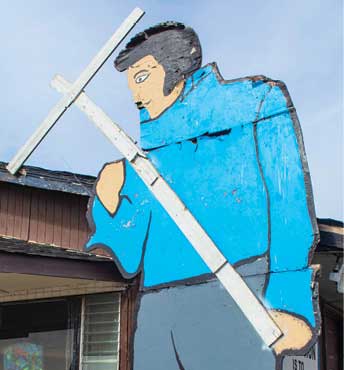Interstate travel is often maligned by travelers seeking placid, story-filled landscapes and fascinating places. In the 1980s, Missouri author William Least Heat-Moon wrote the iconic book Blue Highways to celebrate exploration of America’s meandering backroads. The title of this literary classic reflects that at the time secondary roads were depicted in blue on highway maps. Yet those who experience Missouri by leisurely wandering the backroads are but a fraction of those who experience Missouri from its interstate highways. These highways carry tens of millions of people passing through Missouri’s shifting landscapes, forests, and prairies, driving under wide-open skies and soaring skyscrapers. If you look at a Rand McNally map today, you’ll see that interstates are now depicted in blue. Over the next three issues, we will explore the curiosities and dramatic stories that line these new blue highways: Missouri’s interstates.
The Show-Me state has much to show travelers, even at 70 mph!
A Lear jet rests beside the highway without an airport in sight. A Ferris wheel sits idly in a field. A forlorn brick chimney rises out of a clump of bushes. These are but a few of the curiosities that travelers speed past on their way across Missouri on Interstate 70 between St. Louis and Kansas City. Entertainment abounds on the nation’s oldest interstate highway. You have but to stop and look.
The first European settlers crossed Missouri from east to west on routes that parallel the path of I-70—horse and wagon trails such as the Boonslick Trail or boat treks on the riverine trail of the Missouri River. Later the railroads and then US 40 took people across the state. In 1956, work began on US 40 in St. Charles County to upgrade the federal highway to I-70, the first in President Dwight D. Eisenhower’s new interstate system. Today, this major transportation artery bisects the Show-Me State, carrying people from one side to the other in just a few hours. But what’s the hurry? Next time you travel on I-70, take a few moments to explore some of the unusual sights and sounds of the I-70 circus. We start in St. Louis and cross the state to Kansas City.
Love Me Tender • Mile 199
Look for a 16-foot statue of Elvis carrying a cross on the north side of the highway in Wright City. This is the former home of the Elvis is Alive! Museum, and the statue originally depicted Elvis holding a microphone stand. In 1992, a Baptist minister named Bill Beeny converted an empty laundromat into a museum dedicated to proving that Elvis did not die in 1977. Displays included declassified files released by the FBI, photographs, books, DNA reports, and replicas of his gravestone, his Cadillac, and the casket from the 1977 funeral complete with a wax Elvis cadaver in it. In 2007, Pastor Beeny, then in his 80s, sold the entire museum on eBay to a man who moved it to Mississippi with the promise of carrying on the mission to uncover the truth. Today, at this Missouri location, Elvis’s mic stand has been turned into a cross, and Bill Beeny, now in his 90s, serves as the pastor overseeing the Baptist Mission and Food Pantry. The mission’s message and food bank demonstrate tender love for residents of Warren County, for which you can imagine these community members say, “Thank you! Thank you very much!”
A Ghostly Ferris Wheel • Mile 180
On the north side of the road, you will see a 40-foot Ferris wheel standing alone in a field with nary a child, elephant ear, or snow cone in sight. This rather surreal scene near High Hill marks the property of Tinsley’s Amusements Inc., a carnival company that provides more than 20 carnival rides ranging from kiddie rides to thrill rides as well as food stands and games for state fairs, county fairs, carnivals, and neighborhood, school, or church festivals throughout Illinois and Missouri. Rich Tinsley, the founder, has been in the amusement business since 1946 when as a 9-year-old he helped his dad rent and run two
pedal-car kiddie rides.
Since beginning his own show in 1971, Tinsley’s amusement business has grown to the largest in Missouri. The Ferris wheel (lit in festive lights at night) is well traveled. Tinsley bought the Ferris wheel in 1954 and placed it at Holiday Hill Amusement Park in St. Louis. Each winter, it was moved down to south Florida and placed on top of a Miami building as a Christmas decoration. After the St. Louis park closed, Tinsley moved the Ferris wheel to New York’s Coney Island boardwalk, then to the Poconos in Pennsylvania, and then back to St. Louis’s Union Station until 1998. Now, it’s permanently at home here alongside I-70.
Petticoats of Peace • Mile 170.8
You might glimpse an old white wooden building on the north side of the interstate. No ornate architecture or flashing sign draws the attention of highway travelers, but this simple structure has an exciting story of how it was one of the only buildings in Danville to survive when rebel sympathizers torched the town nearly 155 years ago. From 1853 to 1865, this was the chapel and dormitory of the prestigious Danville Female Academy. On October 14, 1864, Capt. William T. “Bloody Bill” Anderson’s pro-Confederate rangers rode into Danville and set fire to any structure thought to harbor Union troops. As the town went up in flames, the men approached the academy and demanded to enter. The girls called out from the upstairs windows and begged the men not to harm them or the school. Stories say that some of the clever ladies mentioned that they were Southerners themselves since the students were from all parts of Missouri and even other states. One girl hung her white petticoat outside the front door as a flag of peace. Other tales say that girls waved a whole wardrobe of petticoats out the windows to convince the guerrillas of either their Southern loyalty or to ask for peace. The men finally promised not to harm them or their school, and so it was saved by the brave and savvy women—and at least one white petticoat.
Stories in the Rock • Mile 168
Rocks tell tales. You can see them in the road cuttings at several locations along I-70 that expose rock layers containing shark teeth and fossils of prehistoric marine life, remnants of an ancient warm sea that once covered the region. But one particular rock on I-70 tells a different tale—a story of human history and preservation. A large sandstone rock formation sits on the grass slope in the center median. In 1884, Montgomery County celebrated the Old Settler’s Reunion on this rock located on Dr. Robert Graham’s family property near Mineola. Soon after, the rock became known as Picnic Rock or Graham Rock and was the setting of many gatherings of family and friends.
In 1951, the rock became a roadside park for US 40 travelers. That same year, the State Highway Commission of Missouri signed a contract with members of the Graham family agreeing that the rock would never be disturbed by any future construction. As construction of I-70 stretched through here in 1963, the contract preserved the rock, which remained solidly between the eastbound and westbound lanes.
But local lore suggests that the rock may have a darker history. Some believe the rock was used for slave auctions even though no firm evidence has ever been found to confirm these stories. Even so, the rock is also known as “Slave Rock” along this stretch of highway. In 2013, Governor Jay Nixon vetoed the renaming of “Slave Rock” to “Graham’s Picnic Rock Highway,” claiming that it would ignore the fact that “shameful” auctions may have occurred there. Rocks tell stories, but some of these stories are shrouded in uncertainty.
In Praise of Prairie • Mile 145
We say of the oak, “How grand of girth!”
Of the willow we say, “How Slender!”
And yet to the soft grass clothing the earth
How slight the praise we render.
—Edgar Fawcett (American-English novelist and poet)
People do sing the praises of grass at the Tucker Prairie Natural Area south of the interstate. It is easy to speed by this unassuming landscape without even noticing it. But much like oceans, where life teems beneath the surface, the diverse mixture of prairie plants and animals is often concealed in the grasses. This 146-acre prairie is particularly special because it has never been disturbed by the plow, and more than 250 species of plants have been found here. The Callaway County tract is owned by the University of Missouri and is used for class projects and research. Nature lovers can access this unique preserve, too.
The word “prairie” comes from the French word for a grassy meadow. Prairies are a mix of wildflowers and grasses with deep root systems that tap into groundwater up to 15 feet below the surface. This ensures their survival even in the driest Missouri summers. When Europeans first traveled to Missouri, prairies blanketed one-third of the state. Today because of conversion to croplands and urban uses, less than one-half of 1 percent of Missouri’s original prairie remains. Tucker Prairie is the largest prairie remnant in mid-Missouri.
Liquid Sunlight • Mile 115.5
Galileo said, “Wine is sunlight, held together by water.” At exit 115 just west of Columbia, you’ll find one of the largest purveyors of liquid sunlight in Missouri: Les Bourgeois Vineyards. This Rocheport winery’s romantic overlook of the Missouri River makes it a popular venue for tying the knot. Each year, the winery hosts an art competition that allows people from anywhere in the United States to design artsy labels for the bottles in the LBV “Collector’s Series” of wine. Perhaps interesting labels help sell bottles of wine (not that they need any help) just as a cover helps sell a book.
Check out the view from the bluff top before making your way back to I-70. As you cross the Missouri River, look over your shoulder and you’ll see the winery perched high atop the bluff on the north side of the river.
Bud Wiser • Mile 111
On the north side of the highway, just before exit 111, you can catch a glimpse of a stately long white fence surrounding a farm furnished for the king’s horses. The Warm Springs Ranch near Boonville is the world’s largest breeding facility for the famous Budweiser Clydesdales. In parades, NASCAR races, the Super Bowl, and other events, teams of Clydesdales have pulled wagons carrying the “King of Beers.” Between April and October, the ranch offers guided walking tours and private VIP tours of the 25,000-square-foot breeding facility and 300 acres of pasture. It usually takes about four years before the new foals are fully trained and “hitch eligible.” Then the young horses join traveling teams based in St. Louis, New Hampshire, or Colorado.
In 2008, Anheuser-Busch moved the breeding herd from Menifee, California, to be closer to the brewer’s St. Louis headquarters. As many as 150 horses reside here. Before they pulled the signature red and gold beer wagon, this 6-foot-tall, 2,000-pound breed bore powerful farm horses along the River Clyde, which was in a valley, or “dale,” in Lanarkshire, Scotland. These large, lovable horses have been a part of Budweiser’s history since 1933 when August Busch Jr. presented his father a gift of six Clydesdales and a wagon to carry the first case of post-Prohibition beer from their brewery. Stop by the farm for a tour, chat with a Clydesdale handler, get your selfie with the upcoming Bud Wagon Superstars, and you will become a bit Bud wiser.
A Fire Place • Mile 70.6
The brick chimney with the TV antenna still attached is all that remains from a three-bedroom home destroyed by an electrical fire in February 2001. After all these years, the old-fashioned TV antenna—from some angles looking like a cross—still stands resolutely over the solemn site. Cassy Banks, who owns the home, drives past this Saline County spot twice a day on her way to and from work. She leaves the chimney standing as a reminder of the fire that changed her life.
“This was the first, and only, home I have ever purchased,” she says. “To lose the house was devastating, but more devastating was to lose the contents inside the home that can never be replaced—the pictures, yearbooks, childhood toys, and family furniture. Those are the things I think about each time I drive past on I-70. To lose everything is hard to overcome and I still feel sad. Someday, when I purchase another home, I will take down the chimney and use the bricks to build a fire pit in the backyard. And if I never buy another home, the chimney will remain standing as a reminder.”
Cassy has rebuilt her life and moved on with a new appreciation for the things she has and a deeper sympathy for victims of disasters whose homes are destroyed. Let it remind us, too!
Concordia—Anything But! • Mile 58
German immigrants settled here in Lafayette County in 1860 and named the place Concordia, meaning “harmony.” But the town’s early days were anything but harmonious. On October 10, 1864, bushwhackers killed 25 men from Concordia. Bushwhackers were ragtag renegade groups of men with Southern sympathies who roamed the countryside looting and burning farms and villages. Most German citizens opposed slavery and so were targeted by the bushwhackers. As William Quantrill’s group of guerrillas neared Concordia, some of the townspeople rode out to meet them (near mile 62 in present-day Emma). Here, nearly all the men from Concordia lost their lives, and four more were killed in their homes. Adjacent to the south side of I-70, just past the Concordia exit, is a cemetery with nine tombstones that read: “October 10, 1864.” Fifteen Civil War soldiers are also buried here. Many of the tombstones in this cemetery have beautifully intricate headstones with German inscriptions.
Look, A Lear! • Mile 30.4
Just past Bates City, look on the north side of I-70 and you can see a 1960s vintage Lear 23 jet poking through the trees. This marks White Industries, founded in 1956, one of the largest and oldest suppliers of used airframe, engine, and avionics parts. You might also glimpse the tails of the 2,800 aircraft in the company’s inventory. White acquires 100 to 120 planes a year. Although most are flown in, landing on the 4,400-foot runway, others are salvaged from accident scenes and brought by truck. Over the years, White has recovered disabled or crashed planes from such difficult places as a fishing camp on Canada’s Great Slave Lake, a glacier in Greenland, and a West African rainforest.
The jet on roadside display is an amazing piece of aviation lore. Created by eccentric genius Bill Lear, who without a high school education invented the 8-track stereo and the first car radio, the Lear Model 23 was among the first corporate/private jets. The Lear 23 had astonishing performance. With two pilots and a full load of five passengers, it could climb to 40,000 feet in a little more than seven minutes.
Find more stories of Interstate 70 in Ted Cable and LuAnn Cadden’s book, Driving across Missouri: A Guide to I-70, published by University Press of Kansas.
Photography by Edward Lang
Related Posts
Here’s Our Guide to Growing Native Plants
By landscaping with native Missouri plants, gardeners with the palest of green thumbs can enjoy such views just like the pros, all while knowing they’ve done their part to nurture complex ecosystems.
Your Guide to The Nutcracker & Where to See It
Local productions and traveling shows bring the iconic ballet to appreciative audiences here in Missouri. For professional ballet companies, The Nutcracker is often the most popular show of the season.
Your Guide to Food, Wine, & Sweets in Columbia
Wine, chocolate, barbecue … whatever fare you fancy, you’ll find it in Columbia. The city has attracted talented purveyors and restaurateurs who take pride in satisfying even the most particular palate. Here are just a few of the businesses that give the city its flavor.











